1,2,4,5-Tetrazine based ligands and complexes
Abstract
One of the most intriguing nitrogen based aromatic heterocycles is 1,2,4,5-tetrazine or s-tetrazine (TTZ) thanks to its electron acceptor character and fluorescence properties and the possibilities of functionalization in the 3 and 6 positions allowing access to various ligands. In this review we focus on the two main families of TTZ based ligands, i.e. ditopic symmetric and monotopic non-symmetric, together with their metal complexes, with a special emphasis on their solid state structures and physical properties. After a description of the most representative complexes containing unsubstituted TTZ as a ligand, symmetric TTZ ligands and complexes derived thereof are discussed in the order: 3,6-bis(2-pyridyl)-tetrazine, 3,6-bis(3-pyridyl)-tetrazine, 3,6-bis(4-pyridyl)-tetrazine, 3,6-bis(2-pyrimidyl)-tetrazine, 3,6-bis(2-pyrazinyl)-tetrazine, 3,6-bis(monopicolylamine)-tetrazine, 3,6-bis(vanillin-hydrazinyl)-tetrazine and TTZ containing carboxylic acids. Remarkable results have been obtained in recent years for metal–organic frameworks and magnetic compounds in which magnetic coupling is enhanced when the tetrazine bridge is reduced to radical anions. Non-symmetric ligands, such as dipicolylamine-TTZ and monopicolylamine-TTZ, are comparatively more recent than the symmetric ones. They allow in principle the preparation of mononuclear complexes in a controlled manner, although binuclear complexes have been isolated as well. Moreover, in the monopicolylamine-TTZ-Cl ligand, deprotonation of the amine, thanks to the electron acceptor character of TTZ, afforded a negatively charged ligand equivalent of a guanidinate.

- This article is part of the themed collection: 2020 Frontier and Perspective articles


 Please wait while we load your content...
Please wait while we load your content...